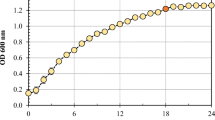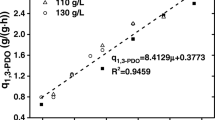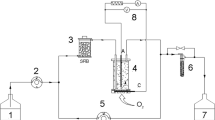Abstract
Anaerobic glycerol degradation by a mixed microbial culture from a fermenter fed with industrial alcohol distillation waste water, was investigated in the absence or presence of sulfate, at 37°C and at a constant pH of 7.2. In the absence of sulfate, glycerol utilization was found to be characterized by the transient formation of 1,3-propanediol prior to propionate and acetate accumulation. In the presence of sulfate, 1,3-propanediol production was minor, and the carbon balance reflected a considerable accumulation of intermediate(s). A study of the role of sulfate reduction and methanogenesis on anaerobic 1,3-propanediol degradation showed that consumption of this substrate by the mixed microbial culture required a terminal electron acceptor. The number of fermentative and sulfate-reducing bacteria with glycerol or 1,3-propanediol as carbon and energy source revealed that sulfate-reducing bacteria outcompete fermentative bacteria for these substrates. The possible ecological role of sulfate-reducing bacteria in the metabolism of these reduced substrates is discussed.
Similar content being viewed by others
Literature Cited
Batlle JL, Collon Y (1979) Dosage enzymatique en flux continu du glycérol dans les vins. Conn Vigne Vin 1:45–50
Bories A (1981) Méthanisation des eaux résiduaires de distilleries. Trib Cebedeau, 456:475–483
Bories A, Raynal J, Jover JP (1982) Fixed film reactor with plastic media for methane fermentation of distilleries. In: Strub A, Chartier P, Schleser G (eds) Energy from biomass. London: Applied Science Publisher, pp 567–571
Bryant MP, Wolin EA, Wolin MJ, Wolfe RS (1967)Methanobacillus omelianskii, a symbiotic association of two species of bacteria. Ark Mikrobiol 59:20–31
Cord-Ruwisch R (1985) A quick method for the determination of dissolved and precipitated sulfides in cultures of sulfate-reducing bacteria. J Microbiol Methods 4:33–36
Cord-Ruwisch R, Ollivier B, Garcia JL (1986) Fructose degradation byDesulfovibrio sp. in pure culture and in coculture withMethanospirillum hungatei. Curr Microbiol. 13:285–289
Dubourguier HC, Samain E, Prensier G, Albagnac G (1986) Characterisation of two strains ofPelobacter carbinolicus isolated from anaerobic digesters. Arch Microbiol 145:248–253
Eichler B, Schink B (1984) Oxidation of primary aliphatic alcohols byAcetobacterium carbinolicum sp. nov., a homoacetogenic anaerobe. Arch Microbiol 140:147–152
Emde R, Schink B (1987) Fermentation of triacetin and glycerol byAcetobacterium sp. No energy is conserved by acetate excretion. Arch Microbiol 149:142–148
Esnault G, Caumette P, Garcia JL (1988) Characterization ofDesulfovibrio giganteus sp. nov., a sulfate-reducing bacterium isolated from a brackish coastal lagoon. System Appl Microbiol 10:147–151
Forage RG, Foster MA (1982) Glycerol fermentation inKlebsiella pneumoniae: functions of the coenzyme B12-dependent glycerol and diol dehydratases. J Bacteriol 149:413–419
Forsberg CW (1987) Production of 1,3-propanediol from glycerol byClostridium acetobutylicum and otherClostridium species. Appl Environ. Microbiol 53:639–643
Gunsalus IC (1947) Products of anaerobic glycerol fermentation byStreptococcus faecalis. J Bacteriol 54:239–244
Hobbie JE, Daley RJ, Jasper S (1977) Use of nucleopore filters for counting bacteria by fluorescence microscopy. Appl Environ Microbiol 33:1225–1228
Hungate RE (1960) Microbial ecology of rumen. Bacteriol Rev 24:353–364
Joubert WA, Britz TJ (1987) Isolation of saccharolytic dissimilatory sulfate-reducing bacteria. FEMS Microbiol Lett 48:35–40
Kremer DR, Hansen TA (1987) Glycerol and dihydroxyacetone dissimilation inDesulfovibrio strains. Arch Microbiol 147:249–256
Landre J (1983) Détermination du carbone organique total dans les eaux potables par oxydation U.V. Eau Industries Nuisances 71:25–28
Laroche M (1983) Métabolisme intermédiaire des acides gras volatils en fermentation méthanique. Thése doctorat, Institut National Des Sciences Appliquées, Toulouse, France
Macy JM, Snellen JE, Hungate RE (1972) Use of syringe methods for anaerobiosis. Am J Clin Nutr 25:1318–1323
McInerney MJ, Bryant MP, Pfennig N (1979) Anaerobic bacterium that degrades fatty acids in syntrophic association with methanogens. Arch Microbiol 122:129–135
Mickelson MN, Werkman CH (1940) The dissimilation of glycerol byColi-aerogenes intermediates. J Bacteriol 39:709–715
Nakas JP, Chaedle MS, Parkinson CM, Coonley CE, Tannenbaum SW (1983) System development of linked fermentation production of solvents from algal biomass. Appl Environ Microbiol 46:1017–1023
Nanninga HJ, Gottschal JC (1986) Isolation of a sulfate-reducing bacterium growing with methanol. FEMS Microbiol Eco 38:125–130
Nanninga HJ, Gottschal JC (1987) Properties ofDesulfovibrio carbinolicus sp. nov. and other sulfate-reducing bacteria isolated from an anaerobic-purification plant. Appl Environ Microbiol 51:572–579
Ollivier B, Cord-Ruwisch R, Hatchikian EC, Garcia JL (1988) Characterization ofDesulfovibrio fructosovorans sp. nov. Arch Microbiol 149:447–450
Postgate JR (1984) The sulfate reducing bacteria, 2nd ed London: Cambridge University Press
Qatibi AI (1990) Fermentation du lactate, du glycérol et des diols par les bactéries sulfato-réductrices du genreDesulfovibrio. Thèse doctorat, Univer. Aix-Marseille I, France
Qatibi AI, Bories A (1988) Glycerol fermentation and sulfate utilization during the anaerobic digestion process. In: Tilche A, Rozzi A (eds) Fifth Intern. Symp. Anaerobic Digestion, Monduzzi Editore, Bologna, pp 69–73
Qatibi AI, Garcia JL (1989) Glycerol degradation byDesulfovibrio sp., in pure culture and in coculture withMethanospirilum hungatei. In: FEMS Symp. microbiology and biochemistry of strict anaerobes involved in interspecies hydrogen transfer. New York: Plenum Publ. Corp., in press
Qatibi AI, Cayol JL, Garcia JL (1989) 1,2- and 1,3-propanediol degradation byDesulfovibrio alcoholovorans sp. nov., in pure culture or through interspecies transfer. In: FEMS Symp. microbiology and biochemistry of strict anaerobes involved in interspecies hydrogen transfer. New-York: Plenum Publ. Corp., in press
Quastel JH, Stephenson M, Whetham MD (1925) Some reactions of resting bacteria in relation to anaerobic growth. Biochem J 19:304–317
Schutz H, Radler F (1984) Anaerobic reduction of glycerol to propanediol-1,3 byLactobacillus brevis andLactobacillus buchneri. Syst Appl Microbiol. 5:169–178
Serjak WC, Day WH, Van Lanen JM, Boruff CS (1954) Acrolein production by bacteria found in distillery grain mashes. Appl Microbiol 2:14–20
Stams A, Hansen TA, Skyring GW (1985) Utilisation of amino acids as energy substrates by two marineDesulfovibrio strains. FEMS Microbiol Lett 31:11–15
Thiamann KV (1955) The life of bacteria. New York: MacMillan Publishing Co
Widdel F (1980) Anaerober Abbau von Fettsaüren und Benzoesaüre durch neu isolierte Arten Sulfat-reduzierender Bakterien. Doctoral thesis, Univ Göttingen, FRG
Widdel F (1988) Microbiology and ecology of sulfate- and sulfur-reducing bacteria. In: Zehnder AJB (ed) Biology of anaerobic microorganisms. New York: John Wiley, pp 469–585
Widdel F, Pfennig N (1977) A new anaerobic sporing acetate-oxidizing, sulfate-reducing bacterium,Desulfotomaculum (emend)acetoxidans. Arch Microbiol 112:119–122
Author information
Authors and Affiliations
Rights and permissions
About this article
Cite this article
Qatibi, AI., Bories, A. & Garcia, JL. Sulfate reduction and anaerobic glycerol degradation by a mixed microbial culture. Current Microbiology 22, 47–52 (1991). https://doi.org/10.1007/BF02106212
Issue Date:
DOI: https://doi.org/10.1007/BF02106212




